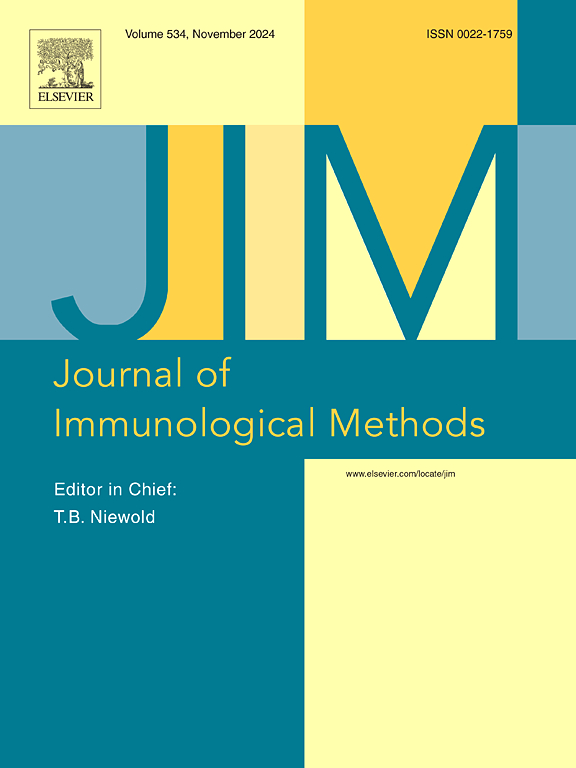Development of vectors for reformatting scFv fragments derived from phage display libraries into native IgG1 structures for in vivo imaging and therapeutic applications
IF 1.6
4区 医学
Q4 BIOCHEMICAL RESEARCH METHODS
引用次数: 0
Abstract
Monoclonal antibodies are a crucial class of therapeutic agents utilized for the treatment of various disorders. Typically, fully human therapeutic antibodies are created using the antibody fragment phage display from naive libraries and are selected against the antigen in a format known as the single-chain Fv (scFv) fragment. To be employed in immunotherapy, the scFv fragment needs to be reformatted into the complete IgG structure with a native-like conformation and expressed in mammalian cells. In this context, we have established an expression system for reformatting scFv fragments into complete IgG1 molecules, enabling both antibody chains to be cloned within the same vector. These constructs are based on the IgGγ1 heavy chain, with the light chain belonging to either the lambda or kappa isotype. For in vivo imaging, we have designed vectors with specific mutations in the IgG1 lower hinge region and CH2 domain to impede the antibody's effector function, ensuring that immune cells are not activated. The efficiency of this expression system was evaluated by producing two antibodies: one with the lambda light chain and the other with the kappa light chain. Their expression levels were assessed in HEK-293 and CHO-K1 cell lines. Structurally, the resulting antibodies are properly assembled and folded into their quaternary structure, while functionally, these immunoglobulins specifically recognize the antigens and inhibit cancer cell invasion.
开发从噬菌体展示文库中提取的scFv片段重组为原生IgG1结构的载体,用于体内成像和治疗应用
单克隆抗体是一类重要的治疗药物,用于治疗各种疾病。通常情况下,使用来自原始文库的抗体片段噬菌体展示来创建完整的人类治疗性抗体,并以单链Fv (scFv)片段的形式选择抗原。为了应用于免疫治疗,需要将scFv片段重组为具有天然构象的完整IgG结构,并在哺乳动物细胞中表达。在这种情况下,我们建立了一个表达系统,将scFv片段重新格式化为完整的IgG1分子,使两个抗体链能够在同一载体中克隆。这些结构基于igg - γ1重链,轻链属于lambda或kappa同型。对于体内成像,我们设计了在IgG1下铰链区和CH2结构域具有特异性突变的载体,以阻止抗体的效应功能,确保免疫细胞不被激活。通过产生两种抗体来评估该表达系统的效率:一种带有lambda轻链,另一种带有kappa轻链。检测其在HEK-293和CHO-K1细胞株中的表达水平。在结构上,产生的抗体正确组装并折叠成其四级结构,而在功能上,这些免疫球蛋白特异性识别抗原并抑制癌细胞的侵袭。
本文章由计算机程序翻译,如有差异,请以英文原文为准。
求助全文
约1分钟内获得全文
求助全文
来源期刊
CiteScore
4.10
自引率
0.00%
发文量
120
审稿时长
3 months
期刊介绍:
The Journal of Immunological Methods is devoted to covering techniques for: (1) Quantitating and detecting antibodies and/or antigens. (2) Purifying immunoglobulins, lymphokines and other molecules of the immune system. (3) Isolating antigens and other substances important in immunological processes. (4) Labelling antigens and antibodies. (5) Localizing antigens and/or antibodies in tissues and cells. (6) Detecting, and fractionating immunocompetent cells. (7) Assaying for cellular immunity. (8) Documenting cell-cell interactions. (9) Initiating immunity and unresponsiveness. (10) Transplanting tissues. (11) Studying items closely related to immunity such as complement, reticuloendothelial system and others. (12) Molecular techniques for studying immune cells and their receptors. (13) Imaging of the immune system. (14) Methods for production or their fragments in eukaryotic and prokaryotic cells.
In addition the journal will publish articles on novel methods for analysing the organization, structure and expression of genes for immunologically important molecules such as immunoglobulins, T cell receptors and accessory molecules involved in antigen recognition, processing and presentation. Submitted full length manuscripts should describe new methods of broad applicability to immunology and not simply the application of an established method to a particular substance - although papers describing such applications may be considered for publication as a short Technical Note. Review articles will also be published by the Journal of Immunological Methods. In general these manuscripts are by solicitation however anyone interested in submitting a review can contact the Reviews Editor and provide an outline of the proposed review.

 求助内容:
求助内容: 应助结果提醒方式:
应助结果提醒方式:


